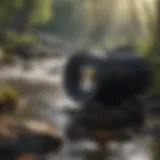The Lewis and Clark Expedition: Journey Across America


Nature Topic Overview
The Lewis and Clark Expedition was a significant journey that explored the vast landscapes of America. From 1804 to 1806, Meriwether Lewis and William Clark led this adventure with a team known as the Corps of Discovery. Their mission was to find a water route to the Pacific Ocean and gather knowledge about the land, people, and animals they would encounter.
This expedition did not just map the land; it opened doors to scientific discovery and cultural exchanges. They documented hundreds of plant and animal species, many of which were previously unknown to European settlers. The expedition is a great example of the spirit of exploration and the quest for knowledge.
Motivations Behind the Expedition
The motivations for Lewis and Clark's journey were multifaceted. President Thomas Jefferson commissioned the expedition after the Louisiana Purchase in 1803, which doubled the size of the United States. Jefferson wanted to understand the new territory better and find practical routes for commerce.
Challenges Faced
The journey was not without obstacles. Lewis and Clark had to navigate through challenging terrains, including mountains and rivers. They faced extreme weather, diseases, and the ever-present threat of wildlife. Each challenge tested their determination and survival skills.
Fun Facts and Trivia
- Firsts: Lewis and Clark were among the first Americans to cross the Rocky Mountains.
- Native Tribes: They interacted with several Native American tribes, including the Shoshone, Nez Perce, and Mandan. Many tribes provided crucial assistance during the journey.
- Animal Sightings: They observed a variety of wildlife, including grizzly bears, elk, and bald eagles.
Interesting Facts
- The expedition covered about 8,000 miles.
- Lewis kept a detailed journal, documenting both scientific findings and daily events.
"The Lewis and Clark Expedition opened vast areas of the American West to exploration and settlement."
Wildlife Explorations
During their journey, Lewis and Clark encountered diverse species of plants and animals. They documented about 178 species of birds, mammals, fish, and plants. Some of these species were entirely new to the world at that time.
Key Species
- Mountain Goat: An expert climber, they thrive in steep, rugged environments.
- Buffalo: These large herbivores were crucial to Native American tribes and the ecosystem.
- California Condor: Once abundant, this bird is known for its impressive wingspan.
Interactive Features
Want to know more about wildlife? Try this simple quiz:
- What animal has the largest wingspan?
- Which animal is known as the king of the jungle?
Environmental Awareness
The Lewis and Clark Expedition serves as a reminder of our connection to nature. As we learn from their journey, it is essential to value and protect our environment.
Importance of Conservation
- Awareness: Understanding ecosystems helps us protect them.
- Responsibility: We can all play a role in conserving nature.
Tips to Help Protect Nature
- Reduce plastic use.
- Plant native trees and flowers.
DIY Nature Activities
Connecting children with nature can spark interest in science and the environment. Here are a few fun activities.
Hands-on Activities
- Nature Journal: Start a journal to document your outdoor discoveries.
- Bird Feeder: Create a simple bird feeder to attract local birds.
- Plant Identification: Go for a walk and observe different plants. Use a guidebook to identify them.
Step-by-step Guide for Crafts
- Craft a Map: Use paper and crayons to draw your own map like Lewis and Clark.
- Outdoor Exploration Challenge: Set up a scavenger hunt to find natures treasures like leaves, rocks, and flowers.
Exploring provides insights into history and encourages a love for nature that can last a lifetime.


Prolusion to the Expedition
The Lewis and Clark Expedition marks a pivotal moment in American history. This journey was not merely a trip across uncharted territory; it represented the aspiration of a young nation. Understanding the significance of this expedition sheds light on the motivations and goals behind it. This section will explore how this expedition contributed to the knowledge of the land, the relationship between diverse cultures, and the advancement of scientific understanding.
Historical Context
In the early 1800s, the United States was still a young country. The Louisiana Purchase in 1803 doubled the size of the nation, presenting an urgent need to explore and understand the new lands. President Thomas Jefferson was instrumental in initiating this expedition. He saw it as a way to map the geography and encourage trade and settlement. During this time, tensions were present between American settlers and Native American tribes. Many hoped that the successful journey would create pathways for peace and cooperation.
Geographically, the expedition covered vast and varied landscapes, including rivers and mountains. This journey would also increase American interest in westward expansion. The backdrop of the early 19th century, with its political and social challenges, sets the stage for the importance of this expedition.
Goals of the Expedition
The primary goals of the Lewis and Clark Expedition were multi-faceted:
- Mapping the Territory: The explorers aimed to chart a route to the Pacific Ocean.
- Documenting Flora and Fauna: They intended to study new plant and animal species.
- Establishing Trade: Engaging with Native American tribes was vital for fostering economic relationships.
- Geographic Knowledge: Gaining insights into the landscape was crucial for future settlers and explorers.
These objectives highlight the expedition's role in expanding knowledge about the American frontier. The explorers were tasked with collecting valuable information that would serve as a resource for future generations.
"The Lewis and Clark Expedition was not only a journey into unknown lands but also a journey into the heart of a nation seeking to define itself."
This context helps us understand the broader implications of their travels and the legacy that emerged post-expedition.
Key Figures in the Expedition
The Lewis and Clark Expedition gained significance not only through its exploration but also because of the people leading the journey. Key figures like Meriwether Lewis and William Clark played pivotal roles in shaping the expedition's course and success. Their individual skills and backgrounds contributed to the team dynamic and overall mission. It is also essential to recognize the contributions of Sacagawea, whose presence provided invaluable support, representation, and guidance throughout their travels. Understanding these characters enhances appreciation of the expedition's achievements and the complexities involved in their journey across America.
Meriwether Lewis
Meriwether Lewis was an integral part of the expedition, serving as one of its leaders. Born in 1774 in Virginia, Lewis was well-educated and had military experience. This background positioned him as an ideal choice to lead the expedition.
During the journey, Lewis was responsible for documenting the natural resources and making scientific observations. He maintained a detailed journal that included descriptions of plants, animals, landscapes, and interactions with Native American tribes. This documentation has become a vital source of knowledge about the region's flora and fauna.
Lewis also played a crucial role in decision-making processes, often relying on his instincts and knowledge of the land. His leadership was marked by both enthusiasm and moments of uncertainty, showcasing his human side as a leader.
William Clark
William Clark, born in 1770, was Meriwether Lewis's close friend and co-leader of the expedition. Clark's strong leadership qualities complemented Lewis's, making them an effective duo. Before the expedition, he had extensive experience as a surveyor and frontiersman. His expertise in mapping and navigation proved invaluable.
Clark contributed to the expedition by creating accurate maps that charted the new territories. His illustrations and notes captured not only geographical features but also significant landmarks. This mapping effort served future explorers and settlers who sought to navigate the West.
Both men worked well together, but their differing personalities offered a balance. While Lewis often acted with a sense of urgency, Clark provided steady management, which benefited the expedition. Together, they created a cohesive team focused on the exploration objectives.
Significance of Sacagawea
The role of Sacagawea cannot be overlooked when discussing the key figures. Sacagawea was a Shoshone woman who married a French fur trader, Toussaint Charbonneau. She joined the expedition with her infant son, Jean Baptiste, and her presence had multiple significances.
First, Sacagawea served as a translator, helping the explorers communicate with various Native American tribes they encountered. This ability significantly eased tensions and fostered cooperation, leading to the successful acquisition of supplies and information.
Secondly, her knowledge of the land was instrumental. Sacagawea guided the team through unfamiliar terrain, showcasing her skills in navigation.
This aspect contributed to the overall success of the expedition. Her contributions displayed the importance of collaboration and highlighted the often overlooked roles of women and indigenous peoples in history.
"Sacagawea's involvement was a key factor in the expedition's success. Her expertise and insights helped bridge cultural divides."
Preparations for the Journey
The preparations for the Lewis and Clark expedition were critical. These steps ensured that the team had everything needed for their long and difficult journey across the unknown territories of America. Attention to detail during this phase would affect the success of the entire venture.
Selecting the Team
Selecting the right team was essential for the expedition. Lewis and Clark chose men who were strong and capable. They needed people who could face challenges in the wilderness. Many team members were skilled in various areas such as hunting, navigation, and medicine.
The expedition included soldiers, frontiersmen, and even a few people who could speak Native American languages. This diversity brought vital skills to the group and helped in communication with various tribes they met along the way. Each person had a role to ensure that the team could function well under pressure. This careful selection set the foundation for teamwork and survival in a harsh environment.


Gathering Supplies
Gathering supplies was another major undertaking. The team needed food, tools, and equipment to last for an extended journey. They packed items like rifles, ammunition, and cooking utensils. Additionally, they took along scientific instruments for exploring and documenting the land.
Lewis was particularly careful in making sure they had enough food supplies. They planned for hunting along the way but also carried enough non-perishable items.
This foresight in planning was crucial, as the expedition sometimes faced shortages during challenging times in the wilderness.
Tools for making repairs and crafting were essential too. They needed canoes for navigating rivers and sturdy carts for transport over rough terrains. This organized gathering process showcased the seriousness of their mission.
Launching from St. Louis
Launching from St. Louis marked the real start of the expedition. This city was chosen for its accessibility and strategic location along the Missouri River. It served as the last point of civilization before heading into the wilderness. Before departure, there was a blend of excitement and anxiety.
The group gathered on May 14, 1804. They had rehearsed their journey but could not predict the many surprises ahead. The launch was a significant moment, full of hope and ambition.
The team faced a vast and wild territory that was largely unknown. They had to depend on their training, instincts, and the resources they prepared. Launching from St. Louis symbolizes the beginning of exploration, courage, and the spirit of adventure that drove the Lewis and Clark Expedition.
Journey Through the Wilderness
The journey through the wilderness was a pivotal part of the Lewis and Clark Expedition. It played a significant role in addressing both the immediate goals and the broader consequences of their travels. The vast and complex landscapes that the explorers traversed demanded skill, endurance, and adaptability. Their experiences navigating through uncharted territories helped to expand the understanding of America’s geography and its native cultures.
Navigating Rivers and Mountains
As the expedition advanced, navigating rivers and mountains became essential. The Missouri River was their main transit route initially. Lewis and Clark relied on river currents for swift travel and on local knowledge for safe passages. They encountered formidable mountain ranges such as the Rocky Mountains. This presented challenges like steep ascents and unpredictable weather.
The health and morale of the team were often at risk during these stretches. They had to deal with fatigue and injuries while finding sufficient food and supplies. Overcoming these obstacles demonstrated their tenacity and strategic planning. The explorers meticulously recorded their routes and the topography, which proved invaluable not just for themselves, but for future navigation.
Encounters with Native Tribes
The expedition's encounters with Native Tribes were equally significant. These meetings were often characterized by trade and cultural exchange. The explorers learned from the tribes about the land, which aided them in navigating the wilderness. For instance, the Shoshone tribe provided essential information on routes and local resources.
However, these interactions were not always positive. Misunderstandings sometimes led to tension. Lewis and Clark had to carefully manage their relationships with various tribes. Their reports include valuable insights into the different lifestyles, traditions, and languages they encountered. This documentation serves as a historical account of Native American cultures during that time period.
Challenges Faced Along the Route
Several challenges arose during the expedition that tested the explorers' resolve. Difficult weather conditions, including snow, rain, and extreme heat, complicated their journey. Food shortages were common, as hunting success varied greatly. The group faced the constant threat of illness and injury, which affected morale.
"Difficulties in the wild pushed us to our limits, but perseverance paved the way to discovery."
Additionally, the sheer unpredictability of the terrain made navigation and progress difficult. The expedition faced rapids, muddy trails, and dense forests that required determination to cross. Each of these challenges contributed to the overall narrative of exploration and resilience. In facing adversity, the adventures of Lewis and Clark became a metaphor for discovery itself.
Scientific Discoveries
The Lewis and Clark expedition marked a significant turning point in American scientific exploration. Their journey across uncharted territories revealed numerous new species and provided insight into the geography of previously unknown lands. This section discusses how the expedition advanced scientific knowledge and the lasting effects of these discoveries.
Documenting Flora and Fauna
One of the main objectives of the expedition was to document the rich biodiversity of the regions they explored. Lewis and Clark recorded over 180 new plant species and numerous animal species. They provided valuable descriptions and illustrations of these species, which contributed to the field of botany and zoology.
The meticulous notes taken by Meriwether Lewis hinted at the geography and ecology of the lands. For instance, they discovered the majestic giant sequoia and colorful wildflowers, showcasing the vastness of American flora. The journey also opened the door to understanding ecosystems and their relationships.
Mapping New Territories
Mapping was a crucial task that greatly influenced American understanding of its geography. Lewis and Clark's accurate mapping efforts established new knowledge about the landscape, rivers, and mountains. Their maps became essential resources for future explorers and settlers, influencing routes for trade and migration.
They meticulously noted places like the Missouri, Columbia, and Snake Rivers, providing a clearer picture of Western America. This mapping helped minimize the misconceptions about what lay in the west and paved the way for expansion and discovery.
Impact on Future Expeditions
The findings of Lewis and Clark continued to resonate in scientific communities and influenced future exploration missions. Although daunting, traversing foreign terrains inspired others to follow suit under similar scientific endeavors. Their work laid the groundwork for institutions like the National Geographic Society to emerge later.
Through their documentation, future explorers understood the importance of keeping records for both flora and fauna. Their journals served as a guide, encouraging further scientific inquiry and ecological studies. Thus, the Lewis and Clark expedition not only opened new territories but acted as a catalyst for understanding the American landscape and its natural history.


Cultural Exchanges
The Lewis and Clark Expedition was not just about exploration. It was also a significant event for cultural exchanges between different groups of people. The encounters between the Corps of Discovery and various Native American tribes showcased a complex web of relationships, ideas, and interactions that shaped both the expedition and the cultures involved.
Documenting Indigenous Cultures
During their journey, Lewis and Clark met numerous Native American tribes. Each tribe had its own unique customs, traditions, and ways of life. The explorers made notes and collected information about these cultures. For example, they documented languages, clothing, housing, and food. This documentation was crucial for understanding the rich tapestry of Native American life at that time.
One prominent tribe they encountered was the Shoshone, with whom they had significant interactions. The explorers learned about their hunting practices and trading techniques. Other tribes, like the Mandan and Hidatsa, influenced their understanding of agriculture and shelter. By recording these observations, Lewis and Clark laid an important foundation for future generations to learn about the diverse ways of life that existed in America before widespread settlement by Europeans.
Furthermore, the relationship with Native Americans often involved trade. The explorers exchanged goods like beads, metal tools, and clothing for food, guides, and information about the landscape. This mutual exchange helped to support their journey, illustrating the practical benefits of cultural interaction.
Language and Communication
Communication played a crucial role in the success of the expedition. There were significant language barriers between the explorers and the Native American tribes. Lewis and Clark had to rely on interpreters, including Sakagawea, who helped bridge these gaps. Her knowledge of the Shoshone language was invaluable when negotiating with various tribes.
Misunderstandings could easily have led to conflicts, but because of effective communication, many challenges were navigated peacefully. Language was not only a tool for trading but also a way to share stories, beliefs, and knowledge. Each conversation had the potential to enrich both the explorers’ and the tribes’ understanding of one another.
In summary, cultural exchanges during the Lewis and Clark Expedition were incredibly significant. They fostered a deeper appreciation for the diverse cultures present in North America. The documenting of indigenous cultures and successful communication methods offered insights valuable for understanding America's history.
"The true value of an explorer’s journey lies not only in the lands he discovers but in the cultures he learns from."
Return to St. Louis
The return to St. Louis marked the conclusion of the Lewis and Clark expedition. This event was not just a simple journey home; it symbolized the culmination of an adventure that reshaped the understanding of the American West. The explorers faced numerous challenges and overcame many obstacles during their travels. Their experiences garnered valuable insights that would impact future generations.
Epilogues of the Journey
As Lewis and Clark returned to St. Louis, their minds were filled with memories of breathtaking landscapes and encounters with diverse Native American tribes. The expedition successfully mapped significant portions of the newly acquired Louisiana Territory, providing a wealth of information about plants, animals, and geography. The findings greatly enhanced American knowledge of its terrain.
They documented details about the Columbia River, the Great Plains, and various mountains, including the Rockies. The explorative journey disclosed many unknown aspects of American geography that would be essential for future settlers and explorers. Furthermore, the expedition contributed to a growing national identity, fostering interest in westward expansion and exploration among the American population.
"Lewis and Clark brought back stories and knowledge that inspired others to explore the vast lands beyond the Mississippi River."
Legacy of the Expedition
The legacy left by the Lewis and Clark expedition is immense. Their journey opened pathways for future explorations and settlements in the West. It also served as a vital historical chapter that detailed early American expansion and its complexity.
In education, their story is told to teach about perseverance, collaboration, and respect for diverse cultures. Lessons learned from their interactions with various Native tribes marked the importance of diplomacy and cultural understanding.
Now, many schools include their journey in history curricula, allowing young learners to engage with a significant period in American history. The expedition's contribution to cartography and science is still recognized today, influencing both educational content and geographical knowledge.
The culmination of Lewis and Clark's adventure serves as a guide, showcasing how exploration can connect different cultures and develop a deeper understanding of the land and its people. Through stories, activities, and discussions, educators inspire a sense of adventure in young learners, encouraging them to explore the world around them.
Educational Impact
The Lewis and Clark Expedition serves as a crucial topic in American history, particularly for young learners. It not only highlights the spirit of adventure and exploration but also opens a window to diverse themes in education. By studying this expedition, children can gain insight into important historical contexts, geography, and cultural interactions. The exploration can inspire curiosity about the world and its history.
The significance of this topic can be discussed through several key elements:
- Understanding Geography: Through the journey of Lewis and Clark, learners can identify major rivers, mountains, and landforms. Maps created during the expedition can serve as educational tools. This helps children develop skills in geography and understand the physical layout of the United States.
- Cultural Awareness: The expedition embraced interactions with Native American tribes. This facet provides a chance to learn about indigenous cultures, traditions, and languages. Such knowledge nurtures respect and appreciation for cultural diversity among young learners.
- Scientific Inquiry: Documenting new species and the natural environment showcases the importance of observation and research. Learning about the flora and fauna discovered during the trip can encourage children to explore science. This is exciting and relevant to their everyday lives and surroundings,
"The journey of Lewis and Clark symbolizes not just exploration but also the intersection of cultures and the quest for knowledge."
Exploring these aspects can lay a foundation for critical thinking and enhance discussions about not only historical events but also their long-term implications.
Influencing American History
The Lewis and Clark Expedition had a substantial impact on American history. It expanded the country's understanding of its geography and natural resources. Moreover, it set the stage for future westward expansion. This journey elucidated the reality of diverse landscapes and ecosystems, yielding information that would shape policies and exploration strategies in the years to come. The documentation of different tribes and their lands influenced the relationships between the U.S. government and Native American nations.
Understanding these influences helps children appreciate how historical decisions can resonate through time, affecting the development of a nation and its relationship with various cultures.
Lessons for Young Learners
Young learners can derive meaningful lessons from the Lewis and Clark Expedition. These lessons extend beyond the pages of history books:
- Perseverance: The journey was filled with challenges, from harsh weather to rugged terrain. Learning about these obstacles teaches children the value of determination.
- Teamwork: Lewis and Clark worked closely with their team, including Sacagawea. This underscores the importance of collaboration and communication.
- Curiosity: The expedition embodies the spirit of inquiry. It encourages kids to ask questions about their environment and to explore the unknown.
- Respect for Nature: By documenting the wilderness, the expedition promotes an understanding of environmental conservation. Children can learn to appreciate the delicate balance of ecosystems and the need to protect them.
Incorporating these lessons into educational settings enhances the relevance of history. The expedition’s story becomes a dynamic, engaging, and integral part of a child’s upbringing, nurturing enthusiasm for discovery and knowledge.







